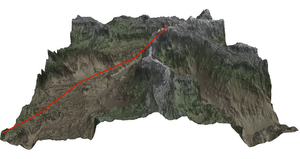Information
- Publication Type: Bachelor Thesis
- Workgroup(s)/Project(s):
- Date: February 2022
- Date (Start): 1. January 2020
- Date (End): 7. February 2022
- Matrikelnummer: 01525536
- First Supervisor:
- Keywords: tessellation, gpu
Abstract
Changing the vertex count of a given geometry through hardware tessellation on the GPU is limited by today’s standards. The capped edge splits (64 splits per edge) as well as increasingly worse performance with deeper levels certainly leaves room for improvement. So in the meantime, software-based solutions using GPU shaders provide much more flexibility as well as features. One possible solution, which we will be focusing on, was presented by Jad Khoury [KDR18] in 2018 which implements a tessellation cache on the GPU. This enables the tessellation step to not only reuse the data of the previous frame but also makes it adaptive by only having to calculate the changes since the last frame. The adaptive cache improves tessellation performance at the cost of memory on the GPU but their particular implementation still slows down on deeper tessellation levels because of the recursive nature of their algorithm. Our work replaces their recursive algorithm with a constant-time solution by exploiting the grid structure of their tessellated geometry.Additional Files and Images
Weblinks
No further information available.BibTeX
@bachelorsthesis{horvath_imp,
title = "Improved Triangle Encoding for Cached Adaptive Tessellation",
author = "Linus Horvath",
year = "2022",
abstract = "Changing the vertex count of a given geometry through
hardware tessellation on the GPU is limited by today’s
standards. The capped edge splits (64 splits per edge) as
well as increasingly worse performance with deeper levels
certainly leaves room for improvement. So in the meantime,
software-based solutions using GPU shaders provide much more
flexibility as well as features. One possible solution,
which we will be focusing on, was presented by Jad Khoury
[KDR18] in 2018 which implements a tessellation cache on the
GPU. This enables the tessellation step to not only reuse
the data of the previous frame but also makes it adaptive by
only having to calculate the changes since the last frame.
The adaptive cache improves tessellation performance at the
cost of memory on the GPU but their particular
implementation still slows down on deeper tessellation
levels because of the recursive nature of their algorithm.
Our work replaces their recursive algorithm with a
constant-time solution by exploiting the grid structure of
their tessellated geometry.",
month = feb,
address = "Favoritenstrasse 9-11/E193-02, A-1040 Vienna, Austria",
school = "Research Unit of Computer Graphics, Institute of Visual
Computing and Human-Centered Technology, Faculty of
Informatics, TU Wien ",
keywords = "tessellation, gpu",
URL = "https://www.cg.tuwien.ac.at/research/publications/2022/horvath_imp/",
}

 thesis
thesis

